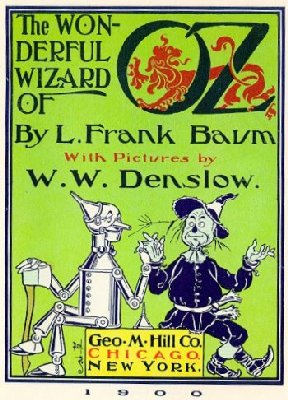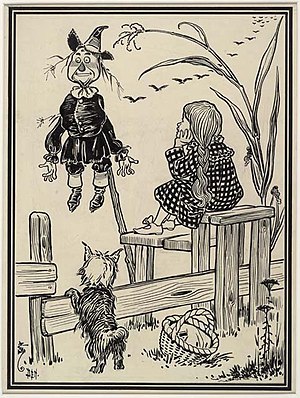 |
| English: Book cover of The Marvelous Land of Oz (1st edition), published in 1904. (Photo credit: Wikipedia) |
In my previous journal entry, I wrote about how the ebook lacked the ability to tab through chapters and was difficult to navigate. This book, however, was not neglected. There is a table of contents which is called a "List of Chapters" rather than a TOC, which can be used to navigate through the book, and the chapters can be tabbed through. However, when pressing the menu button, one may not find "List of Chapters" as one might usually find a "Table of Contents" to go to. So, one must go to the first page and tab through to get to this menu.
This story takes off where the two characters, the tin man and the scarecrow, were left off. We do not get to see Dorothy or Toto again. And, even the lion is no where to be seen. We are also introduced to some new characters. These are: Tip, who is a real boy. There is Jack Pumpkinhead, who has a pumpkin head stuck in a great big smile. Jack is brought to life by Tip. Then there is Woggle-Bug, which is a gigantic bug who was enlarged and became sentient. There is also a Saw-horse that is brought to life. Finally, there is the Gump, which is a flying creature with couches for people to ride in. All of these new inanimate characters were created by Tip, who had stolen it from a witch called Old Mombi. It was a bit of dust that, when given to an object, could turn that object into a living, thinking, caring being.
The strawman has been attacked in his Emerald City and forced to abdicate to an army of girls. Most of the adventures are about the new friends trying to get it back. But, towards the end, we discover that the Emerald City was in fact supposed to be ruled by a girl who had been lost when the original wizard had taken over. Glinda, the good witch, tries to put the rightful heir to the throne back on the throne. It turns out that Tip was that girl. He had had his gender transformed by Old Mombi to hide him. So, he is changed back into a she after the city is taken, and she is placed on the throne.
This story is also highly imaginative, with witty humour and word play banter. It's a short read, but still a lot of fun.





